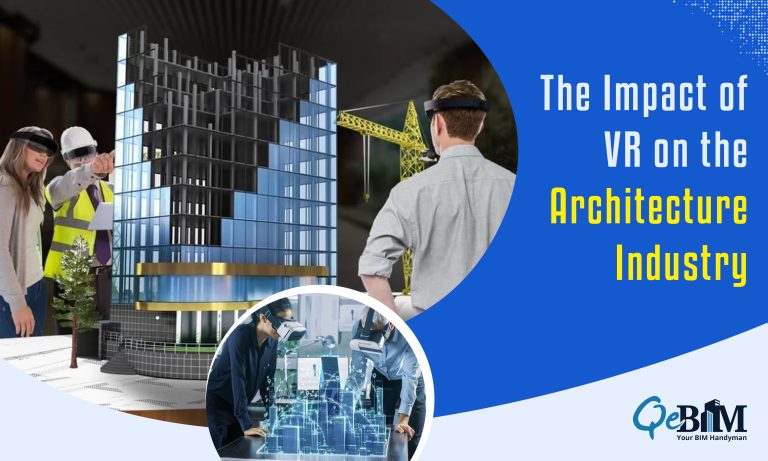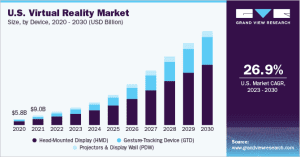The Impact of VR on the Architecture Industry

Introduction
The discipline of architecture has undergone a profound transformation recently as virtual technology keeps on transforming the sector. With the development of virtual solutions like Walkthrough Services as well as Architectural Rendering Services, architects now have strong tools at their disposal to improve the quality of their design procedures.
The architectural business is being quickly transformed by virtual reality (VR) and augmented reality (AR). These technologies allow architects to design more engaging and engaging environments for customers, which has several advantages, involving as:
- Increased client engagement
- Improved communication
- Reduced costs
- Increased productivity
This has led to an increase in the use of VR and AR by property architects. The size of the worldwide virtual reality market, which was estimated at USD 28.41 billion in 2022, will continue to increase at a CAGR of 13.8% from 2023 to 2030 (Refer to Figure1). We’ll look at a couple of the explanations for why property architects make use of virtual reality in this blog article, as well as some of the advantages these tools may provide.
 Figure 1: US Virtual Reality Market (Source – Grand View Research)
Figure 1: US Virtual Reality Market (Source – Grand View Research)
The Power of Walkthrough Services: Unveiling the Virtual World
For clients, providing thrilling experiences is of the utmost importance in the field of property architecture. A revolutionary tool that enables architects to create graphical representations of their projects is called Walkthrough Services. Clients may virtually explore rooms through these experiences that are interactive, helping them to picture the project while it is ever completed. In a recent poll, 75% of architects said that employing walkthrough services had considerably enhanced consumer happiness and results from projects, and the survey was performed by the American Institute of Architects (AIA).
Architectural Rendering Services: Elevating Designs to New Heights
Using Architectural Rendering Services, architects can now produce magnificent visual representations of their construction endeavors as a crucial element of the design process. These photorealistic drawings successfully convey the architect’s vision to customers, investors, and numerous other stakeholders while also capturing the spirit of the design.
Breaking Down the Benefits: Why Architects Are Going Virtual
- Enhanced Collaboration and Communication
Communicating and working together between architects, clients, and other project stakeholders have considerably increased thanks to virtual technologies. Architects may easily exchange designs, get input, and make adjustments in real time using virtual platforms. This simplified procedure promotes greater comprehension, lessens misunderstandings, and makes certain that the construction work moves forward without hitches. - Improved Visualization and Design Decision-making
The way decisions are made for architects has been completely transformed by the capability to visualize designs in a virtual setting. Virtual tools provide places with a realistic portrayal, allowing architects to weigh their alternatives and decide on the best course of action. As a result, clients are happier and design outputs are more accurate. Compared to typical 2D drawings or models, clients who can see a building in VR can have a significantly greater grasp of the design. This may result in better decision-making and increased satisfaction with the end result. - Cost and Time Efficiency
Architects may significantly reduce the time and expenses involved with conventional design processes by implementing virtual solutions. Using virtual walkthroughs and renderings, architects may find problems with a design before construction begins and avoid having to make expensive adjustments. Virtual cooperation also reduces the need for personal interactions, conserving time and money on traveling.
The Future of Property Architecture: Embracing Virtual Innovation
The use of virtual solutions offers a look into the future of building design rather than merely being a fleeting fad. Architects are expected to see further breakthroughs in virtual tools as technology keeps developing. By adopting these advances, architects will be able to push the limits of their innovative thinking and provide unrivaled design experiences.
Global Industry Insights’ analysis projects that by 2026, the virtual reality industry would have grown to an estimated $80.3 billion. Virtual reality has a very promising future for property architects. VR will become ever more immersive and participatory as technology advances. This will enable designers to produce ever more realistic and interesting buildings for their valuable clients.
Additionally, VR is getting easier for people to use. Increasing numbers of people are going to be capable to use VR as headset prices come down. As a result, the demand for VR-based architectural services is going to expand.
Conclusion
For property architects, virtual technologies like Walkthrough Services and Architectural Rendering Services have turned into essential resources. They have a favorable influence on client happiness, project results, and advertising effectiveness, as shown by the data. Architects may increase cooperation, strengthen visualization, and cut expenses while making better choices in design by utilizing these virtual technologies. Adopting virtual innovation as the architectural environment develops is essential to keeping abreast of a field that is getting more and more competitive.